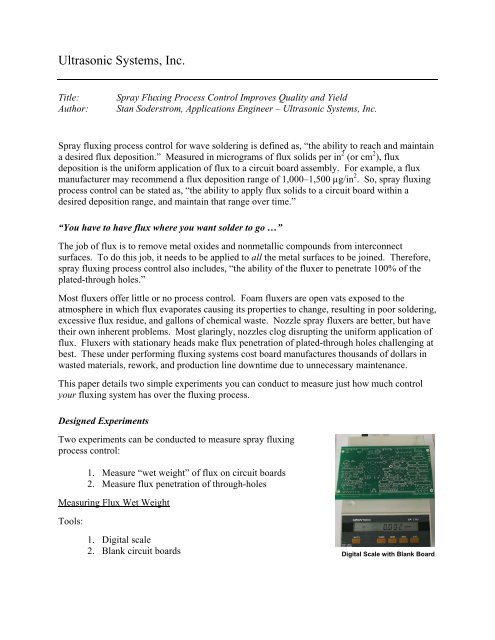Spray fluxing process control: what is it, and how do you ... - Circuitnet
Spray fluxing process control: what is it, and how do you ... - Circuitnet
Spray fluxing process control: what is it, and how do you ... - Circuitnet
You also want an ePaper? Increase the reach of your titles
YUMPU automatically turns print PDFs into web optimized ePapers that Google loves.
Ultrasonic Systems, Inc.<br />
T<strong>it</strong>le:<br />
Author:<br />
<strong>Spray</strong> Fluxing Process Control Improves Qual<strong>it</strong>y <strong>and</strong> Yield<br />
Stan Soderstrom, Applications Engineer – Ultrasonic Systems, Inc.<br />
<strong>Spray</strong> <strong>fluxing</strong> <strong>process</strong> <strong>control</strong> for wave soldering <strong>is</strong> defined as, “the abil<strong>it</strong>y to reach <strong>and</strong> maintain<br />
a desired flux depos<strong>it</strong>ion.” Measured in micrograms of flux solids per in 2 (or cm 2 ), flux<br />
depos<strong>it</strong>ion <strong>is</strong> the uniform application of flux to a circu<strong>it</strong> board assembly. For example, a flux<br />
manufacturer may recommend a flux depos<strong>it</strong>ion range of 1,000–1,500 µg/in 2 . So, spray <strong>fluxing</strong><br />
<strong>process</strong> <strong>control</strong> can be stated as, “the abil<strong>it</strong>y to apply flux solids to a circu<strong>it</strong> board w<strong>it</strong>hin a<br />
desired depos<strong>it</strong>ion range, <strong>and</strong> maintain that range over time.”<br />
“You have to have flux where <strong>you</strong> want solder to go …”<br />
The job of flux <strong>is</strong> to remove metal oxides <strong>and</strong> nonmetallic compounds from interconnect<br />
surfaces. To <strong>do</strong> th<strong>is</strong> job, <strong>it</strong> needs to be applied to all the metal surfaces to be joined. Therefore,<br />
spray <strong>fluxing</strong> <strong>process</strong> <strong>control</strong> also includes, “the abil<strong>it</strong>y of the fluxer to penetrate 100% of the<br />
plated-through holes.”<br />
Most fluxers offer l<strong>it</strong>tle or no <strong>process</strong> <strong>control</strong>. Foam fluxers are open vats exposed to the<br />
atmosphere in which flux evaporates causing <strong>it</strong>s properties to change, resulting in poor soldering,<br />
excessive flux residue, <strong>and</strong> gallons of chemical waste. Nozzle spray fluxers are better, but have<br />
their own inherent problems. Most glaringly, nozzles clog d<strong>is</strong>rupting the uniform application of<br />
flux. Fluxers w<strong>it</strong>h stationary heads make flux penetration of plated-through holes challenging at<br />
best. These under performing <strong>fluxing</strong> systems cost board manufactures thous<strong>and</strong>s of <strong>do</strong>llars in<br />
wasted materials, rework, <strong>and</strong> production line <strong>do</strong>wntime due to unnecessary maintenance.<br />
Th<strong>is</strong> paper details two simple experiments <strong>you</strong> can conduct to measure just <strong>how</strong> much <strong>control</strong><br />
<strong>you</strong>r <strong>fluxing</strong> system has over the <strong>fluxing</strong> <strong>process</strong>.<br />
Designed Experiments<br />
Two experiments can be conducted to measure spray <strong>fluxing</strong><br />
<strong>process</strong> <strong>control</strong>:<br />
1. Measure “wet weight” of flux on circu<strong>it</strong> boards<br />
2. Measure flux penetration of through-holes<br />
Measuring Flux Wet Weight<br />
Tools:<br />
1. Dig<strong>it</strong>al scale<br />
2. Blank circu<strong>it</strong> boards<br />
Dig<strong>it</strong>al Scale w<strong>it</strong>h Blank Board
Procedure:<br />
Results:<br />
1. Place a blank circu<strong>it</strong> board onto the dig<strong>it</strong>al scale <strong>and</strong> zero the scale<br />
2. Remove board from scale <strong>and</strong> run through the <strong>fluxing</strong> system<br />
3. Immediately place board back on the scale<br />
4. Record the flux wet weight<br />
5. Repeat test to prove flux depos<strong>it</strong>ion repeatabil<strong>it</strong>y<br />
Minimal variation in wet flux weight from board to board demonstrates <strong>control</strong> of flux<br />
flow rate <strong>and</strong> spray head traverse speed.<br />
Measuring Flux Penetration of Through-Holes<br />
Tools:<br />
Procedure:<br />
1. Blank circu<strong>it</strong> boards<br />
2. Thermal fax paper (for alcohol-based fluxes), or<br />
pH paper (for water-based fluxes)<br />
1. S<strong>and</strong>wich a piece of appropriate paper between<br />
two blank circu<strong>it</strong> boards<br />
2. Run the s<strong>and</strong>wich through <strong>fluxing</strong> system<br />
3. Inspect the paper for evidence of flux penetration<br />
(the paper will change color in response to the acid in<br />
the flux)<br />
Place Paper Between Boards<br />
Results:<br />
Conclusion<br />
Evidence of flux penetration of all plated-through<br />
holes demonstrates good atomization of the flux, a<br />
well developed <strong>and</strong> repeatable spray pattern, <strong>and</strong><br />
uniform d<strong>is</strong>tribution of flux across the circu<strong>it</strong> board.<br />
<strong>Spray</strong> <strong>fluxing</strong> <strong>process</strong> <strong>control</strong> <strong>is</strong> defined as, “the abil<strong>it</strong>y of a<br />
<strong>fluxing</strong> system to apply flux solids to a circu<strong>it</strong> board w<strong>it</strong>hin a<br />
desired depos<strong>it</strong>ion range, maintain that range over time, <strong>and</strong><br />
Inspect paper for 100% flux throughhole<br />
penetration<br />
penetrate 100% of the plated-through holes of the circu<strong>it</strong> board assembly.” Conducting these<br />
two simple experiments will allow <strong>you</strong> to measure <strong>you</strong>r current fluxer <strong>process</strong>. If flux wet<br />
weights vary significantly, or if <strong>you</strong> are not measuring 100% plated-through hole penetration,<br />
upgrading <strong>you</strong>r fluxer will improve qual<strong>it</strong>y <strong>and</strong> yield.
















